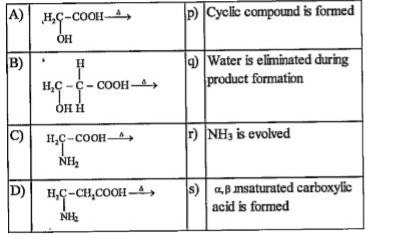Statement 1 : Carboxylic acids ⎛⎜
⎜⎝R−O∣∣C−OH⎞⎟
⎟⎠ have a carbonyl group but it does not give the test of carbonyl group.
Statement 2 : Due to resonance, the double bond character of  group is greatly reduced
Solution in Malayalam
group is greatly reduced
Solution in Malayalam
Statement 1 is True, statement 2 is True, Statement 2 is Correct explanation for Statement 1.
Statement 1 is True, Statement 2 is True, Statement 2 is NOT a correct explanation for Statement 1.
Statement 1 is True, Statement 2 is False.
Statement 1 is False, Statement 2 is True.
The correct Answer is:A
Step by step video, text & image solution for Statement 1 : Carboxylic acids (R-overset(O)overset(||)C-OH) have a carbonyl group but it does not give the test of carbonyl group. Statement 2 : Due to resonance, the double bond character of group is greatly reduced by Chemistry experts to help you in doubts & scoring excellent marks in Class 12 exams.
Updated on:21/07/2023Topper's Solved these Questions
- CARBOXYLIC ACID & THEIR DERIVATIVESBOOK - BRILLIANT PUBLICATIONCHAPTER - CARBOXYLIC ACID & THEIR DERIVATIVESEXERCISE - LEVEL-III (Linked Comprehension Type)
12 Videos
- CARBOXYLIC ACID & THEIR DERIVATIVESBOOK - BRILLIANT PUBLICATIONCHAPTER - CARBOXYLIC ACID & THEIR DERIVATIVESEXERCISE - LEVEL-III (Matching Column Type)
2 Videos
- BIOMOLECULES, POLYMERS AND CHEMISTRY IN EVERYDAY LIFE BOOK - BRILLIANT PUBLICATIONCHAPTER - BIOMOLECULES, POLYMERS AND CHEMISTRY IN EVERYDAY LIFE EXERCISE - LEVEL-II (ASSERTION-REASON TYPE QUESTIONS)
6 Videos
- CARBOXYLIC ACIDSBOOK - BRILLIANT PUBLICATIONCHAPTER - CARBOXYLIC ACIDSEXERCISE - LEVEL-II (Assertion -Reason)
4 Videos
Similar Questions
Paragraph
An organic compound A(C9H6O3) does not react with aqueous solution of NaHCO3 as well as does not change the colour of litmus paper. Aon acid hydrolysis gives B(C9H8O4) as major product whereas A on treatment with one equivalent of methanol in acidic medium gives C(C10H10O4) as the major product (other minor isomer of C is also formed). B on heating with sodalime gives toluene. Answer the following questions based on the above information.
The structure of A satisfying above conditions is
View SolutionMatch the following columns :

View SolutionAssertion : Glucose gives a reddish brown precipitate with Fehling's solution.
Reason : Reaction of glucose with Fehling's solution gives CuO and gluconic acid.
View SolutionAssertion : p-chlorobenzoic acid is more acidic than p-fluorobenzoic acid.
Reason : +R effect of fluorine is higher than that of chlorine due to the matching size of carbon and fluorine.
View SolutionCarboxylic acids donot give the characteristic reactions of carbonyl group. Explain.
View SolutionAssertion : Carbxoylic acids donot give characteristic reactions of carbonyl group. Reason : The carbonyl group is sterically hindered in carboxylic acid.
View SolutionStatement-I: Unlike the gtC=O group of aldehydes and ketones, the C=O of R-overset(O)overset(||)C-OH does not undergo nucleophilic addition reactions. Because Statement-II: Carboxylic acids exist as dimers due to intermolecular hydrogen bonding in aprotic medium.
View Solution(A) Carboxylic acids (R-overset(O)overset(||)C-OH) have a carbonyl group but it does not give the test of carbonyl group. Due to resonance double, the bond character of group is greatly reduced.
View SolutionSTATEMENT-1 : Primary structure of proteins is determined by amino acid sequence.
and
STATEMENT-2 Intramolecular hydrogen bonding between carbonyl group and −∣N−H group is responsible for the folding of polypeptide chain.
View SolutionAssertion: Carboxylic acids contain a carbonyl group but do not give characteristic reactions of the carbonyl group.
Reason: Due to resonance, the electrophilic nature of the carboxyl carbon is greatly reduced as compared to the carbonyl carbon in aldehydes and ketones.
View Solution−O∣∣C−OH समूह का कार्बोनिल समूह, कार्बोनिल समूह की सामान्य नाभिक-स्नेही योग अभिक्रियाएँ नहीं देता, क्यों?
View SolutionSTATEMENT -1 : unlike the > C = O group of aldehyes and ketones, the >C=O of R−O∣∣C−OH does not undergo nucleophillic addition reactions.
and
STATEMENT - 2: Carboxylic acids exist as dimers due to intermolecular hydrongen bonding .
View SolutionAssertion(A): Carboxylic acid do not give the characteristic reaction of carbonyl group as given by aldehyde and ketone.
Reason (R): The carbonyl carbon of carboxylic acid is involved in resonance
View Solutionकार्बोनिल समूह (−∣C=O) के कार्बन पर कौन-सा प्रसंकरण होता है ?
View Solution(A) Carboxylic acids contain a carbonyl group but do not give characteristic reactions of the carbonyl group.
(R) Double bond character of C = O bond in carboxylic acids is greatly reduced due to resonance, as compared to that in aldehydes and ketones.
View Solutionकथन :- ग्लुकॉस 2, 4-DNP परीक्षण नहीं देता है।
कारण :- ग्लुकॉस मुक्त कार्बोनिल समूह नहीं रखता है।
View Solution
